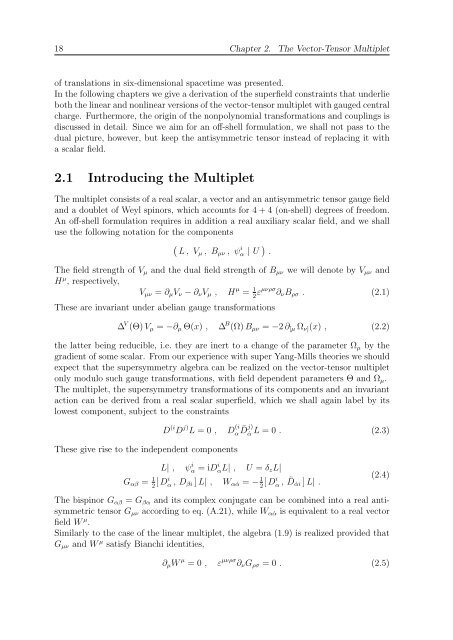N=2 Supersymmetric Gauge Theories with Nonpolynomial Interactions
N=2 Supersymmetric Gauge Theories with Nonpolynomial Interactions
N=2 Supersymmetric Gauge Theories with Nonpolynomial Interactions
You also want an ePaper? Increase the reach of your titles
YUMPU automatically turns print PDFs into web optimized ePapers that Google loves.
18 Chapter 2. The Vector-Tensor Multiplet<br />
of translations in six-dimensional spacetime was presented.<br />
In the following chapters we give a derivation of the superfield constraints that underlie<br />
both the linear and nonlinear versions of the vector-tensor multiplet <strong>with</strong> gauged central<br />
charge. Furthermore, the origin of the nonpolynomial transformations and couplings is<br />
discussed in detail. Since we aim for an off-shell formulation, we shall not pass to the<br />
dual picture, however, but keep the antisymmetric tensor instead of replacing it <strong>with</strong><br />
a scalar field.<br />
2.1 Introducing the Multiplet<br />
The multiplet consists of a real scalar, a vector and an antisymmetric tensor gauge field<br />
and a doublet of Weyl spinors, which accounts for 4 + 4 (on-shell) degrees of freedom.<br />
An off-shell formulation requires in addition a real auxiliary scalar field, and we shall<br />
use the following notation for the components<br />
L , Vµ , Bµν , ψ i α | U .<br />
The field strength of Vµ and the dual field strength of Bµν we will denote by Vµν and<br />
H µ , respectively,<br />
Vµν = ∂µVν − ∂νVµ , H µ = 1<br />
2 εµνρσ ∂νBρσ . (2.1)<br />
These are invariant under abelian gauge transformations<br />
∆ V (Θ) Vµ = −∂µ Θ(x) , ∆ B (Ω) Bµν = −2 ∂[µ Ων](x) , (2.2)<br />
the latter being reducible, i.e. they are inert to a change of the parameter Ωµ by the<br />
gradient of some scalar. From our experience <strong>with</strong> super Yang-Mills theories we should<br />
expect that the supersymmetry algebra can be realized on the vector-tensor multiplet<br />
only modulo such gauge transformations, <strong>with</strong> field dependent parameters Θ and Ωµ.<br />
The multiplet, the supersymmetry transformations of its components and an invariant<br />
action can be derived from a real scalar superfield, which we shall again label by its<br />
lowest component, subject to the constraints<br />
D (i D j) L = 0 , D (i<br />
α ¯ D j)<br />
˙α<br />
These give rise to the independent components<br />
L| , ψ i α = iD i αL| , U = δzL|<br />
L = 0 . (2.3)<br />
Gαβ = 1<br />
2 [ Di α , Dβi ] L| , Wα ˙α = − 1<br />
2 [ Di α , ¯ D ˙αi ] L| .<br />
(2.4)<br />
The bispinor Gαβ = Gβα and its complex conjugate can be combined into a real antisymmetric<br />
tensor Gµν according to eq. (A.21), while Wα ˙α is equivalent to a real vector<br />
field W µ .<br />
Similarly to the case of the linear multiplet, the algebra (1.9) is realized provided that<br />
Gµν and W µ satisfy Bianchi identities,<br />
∂µW µ = 0 , ε µνρσ ∂νGρσ = 0 . (2.5)

















